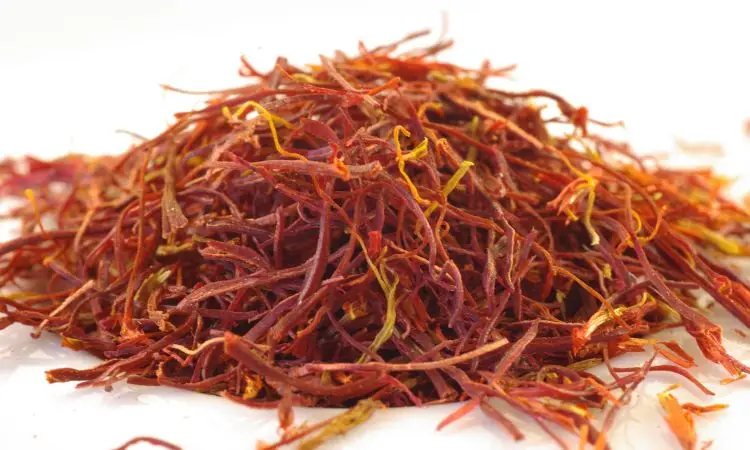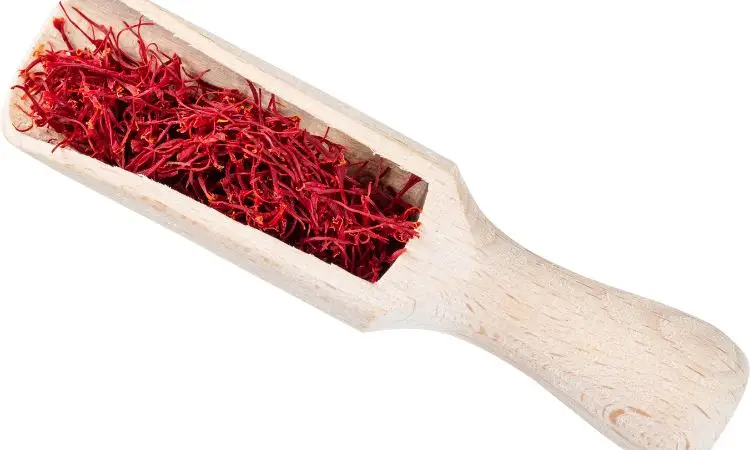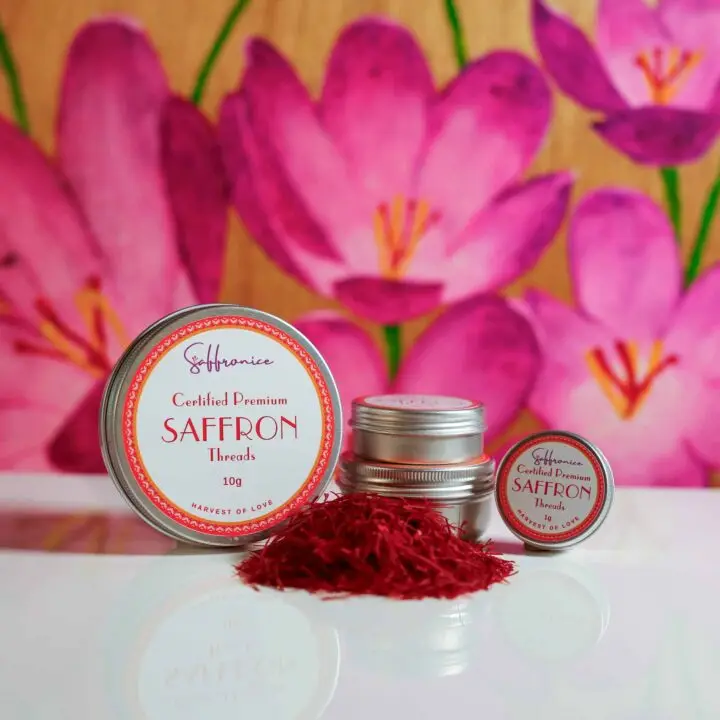📌 Quick Answer: Saffron offers scientifically-proven health benefits including powerful anti-inflammatory and antioxidant properties, mood enhancement for depression and anxiety, cardiovascular protection, cancer-fighting potential, sexual health support, and eye health protection. Clinical studies show effective daily dosages of 30mg for mental health and up to 1.5g for general wellness.
Imagine a spice that’s not just delicious but also boosts your health in remarkable ways. Saffron, the most expensive spice in the world, has been a medicinal treasure for nearly 4,000 years. Derived from the delicate Crocus sativus flower, this golden-red spice contains powerful antioxidants like crocin and crocetin that actively protect your cells from harmful oxidative damage.
To truly understand this remarkable spice, learn what saffron is and discover why modern science continues to validate ancient wisdom about its therapeutic properties.
In this comprehensive article, we’ll explore saffron’s scientifically backed health benefits, from its anti-inflammatory prowess to mood enhancement, heart health support, and cancer prevention potential. Get ready to be amazed by the evidence-based science behind saffron’s extraordinary health wonders!
🔑 Key Takeaways:
- Saffron requires 75,000 flowers to produce just one pound, making it the world’s most precious spice
- Contains powerful antioxidants like crocin, crocetin, and safranal that protect cells from free radicals and oxidative stress
- Clinical studies demonstrate potential to reduce inflammation, improve mood, support heart health, and fight certain cancers
- Versatile applications include cooking, therapeutic teas, and topical skincare treatments
- Generally safe in culinary amounts, but requires medical consultation for therapeutic dosing

Understanding Saffron: Origin and Historical Significance
Saffron’s remarkable journey through history spans nearly four millennia, making it one of humanity’s most treasured medicinal spices. To fully appreciate its significance, explore the comprehensive history and origins of this extraordinary botanical wonder. Its vibrant crimson threads have captivated civilizations across continents, serving as currency, medicine, and culinary enhancement.
Ancient Uses in Traditional Medicine
For nearly 4,000 years, saffron has been revered for its therapeutic properties across diverse ancient civilizations. The Greeks, Romans, Egyptians, and Persians recognized its medicinal potential, incorporating it into traditional medicine practices that modern science now validates. Historical accounts document Cleopatra’s legendary saffron-infused baths, believed to enhance beauty and aphrodisiac qualities.
Chef’s Professional Tip: Ancient Persian physicians prescribed saffron for digestive issues, respiratory problems, and emotional imbalances – applications that align remarkably well with current scientific findings.
The World’s Most Precious Spice
Saffron’s astronomical value reflects the extraordinarily labor-intensive harvesting process that has remained unchanged for millennia. Each delicate Crocus sativus flower yields only three precious stigmas, requiring 75,000 flowers to produce a single pound of saffron threads. This painstaking hand-harvesting process, performed during a brief autumn window, contributes to its market value of $500-$5,000 per pound.
The rarity factor extends beyond labor intensity. Saffron flowers bloom for merely 2-3 weeks annually, and harvesting must occur at dawn when flowers remain closed to preserve stigma quality and potency.
Cultural Importance Across Civilizations
Saffron’s cultural significance transcends its culinary applications, deeply embedded in religious ceremonies, textile dyeing, and medicinal traditions across Middle Eastern, Indian, and European societies. Its golden hue symbolized wealth, purity, and divine connection in various spiritual practices.
| Saffron Production Statistics | Value |
|---|---|
| Global Annual Production | Approximately 300 tons |
| Leading Producer | Iran (76% of global supply) |
| Flowers Required (1 lb/450g) | 75,000 flowers |
| Market Price Range | $500-$5,000 per pound |
The Science Behind Saffron’s Active Compounds
Modern analytical chemistry has identified over 150 bioactive compounds in saffron, with three primary constituents responsible for its therapeutic effects. Understanding these science-backed saffron benefits provides insight into its remarkable health-promoting properties.
Crocin represents saffron’s most abundant carotenoid compound, delivering potent antioxidant and anti-inflammatory effects. Scientific research demonstrates its neuroprotective capabilities, particularly in combating neurodegenerative diseases like Alzheimer’s. Studies also reveal its protective effects against respiratory inflammation and even viper venom toxicity.
Crocetin serves as another crucial bioactive molecule, offering hepatoprotective, cardiovascular, and pulmonary protective benefits. This compound enhances antioxidant enzyme activity while reducing inflammation triggered by environmental toxins and oxidative stress.
Safranal provides saffron’s distinctive aromatic profile while contributing significant therapeutic benefits. Research indicates its effectiveness against inflammation, asthma, hypertension, cancer progression, and depressive symptoms. Emerging studies explore its neuroprotective potential against Alzheimer’s disease.
Food Scientist’s Note: The synergistic interaction between these compounds creates enhanced therapeutic effects that exceed the sum of individual components – a phenomenon known as the “entourage effect.”
Saffron’s Anti-Inflammatory Properties and Mechanisms
Chronic inflammation underlies numerous health conditions, from arthritis to cardiovascular disease. Saffron’s remarkable anti-inflammatory properties offer natural therapeutic potential through multiple sophisticated mechanisms.
Key Anti-Inflammatory Components
Saffron’s flavonoid compounds work synergistically to modulate inflammatory responses throughout the body. These bioactive molecules influence inflammatory pathways at the cellular level, potentially providing relief for various inflammatory conditions, including rheumatoid arthritis, asthma, and inflammatory bowel conditions.
Clinical research demonstrates saffron’s ability to modify inflammatory cascade reactions, potentially offering therapeutic benefits for chronic inflammatory diseases where conventional treatments may have limitations or side effects.
Scientific Research and Clinical Studies
Extensive scientific investigation has documented saffron’s anti-inflammatory mechanisms through both animal models and human clinical trials. Research published in Phytotherapy Research (2013)¹ demonstrated significant reductions in inflammatory markers, including NF-κB, TNF-α, and various interleukins.
Study Spotlight: A 2018 clinical trial published in Phytomedicine² showed that 100mg daily saffron supplementation for 12 weeks significantly reduced inflammatory markers in participants with metabolic syndrome.
Saffron modulates inflammation by inhibiting NF-κB activation while enhancing PPAR-γ expression. Additionally, it affects inflammatory enzymes, including myeloperoxidase (MPO), cyclooxygenase-2 (COX-2), and inducible nitric oxide synthase (iNOS), resulting in comprehensive anti-inflammatory effects.
| Saffron Compound | Anti-Inflammatory Mechanism | Targeted Conditions |
|---|---|---|
| Crocin | Macrophage modulation, cytokine reduction | Atherosclerosis, Asthma |
| Safranal | NF-κB inhibition, enzyme modulation | Arthritis, Cardiovascular Disease |
| Picrocrocin | Antioxidant and anti-inflammatory dual action | Brain Injury, Diabetes |
Antioxidant Power: Protection Against Free Radicals
Saffron’s exceptional antioxidant capacity ranks among the highest measured in natural spices, providing robust cellular protection against oxidative damage. These antioxidants work continuously to neutralize harmful free radicals that contribute to aging, chronic disease, and cellular dysfunction.
The spice’s antioxidant profile includes both water-soluble and fat-soluble compounds, offering comprehensive protection across different cellular environments. This broad-spectrum antioxidant activity makes saffron particularly effective for preventing chronic diseases, including cancer, cardiovascular disease, and neurodegenerative conditions.
Research demonstrates that saffron’s antioxidants provide superior protection compared to many conventional antioxidant supplements, with enhanced bioavailability and sustained cellular protection. Regular consumption may help prevent age-related cognitive decline while supporting overall cellular health and longevity.
| Antioxidant Component | Percentage in Saffron |
|---|---|
| Safranal | 30-70% of volatile components |
| Crocin | Primary contributor to antioxidant activity |
| Crocetin | Significant antioxidant and anti-inflammatory effects |
Mental Health Benefits: Depression and Anxiety Support
Emerging research positions saffron as a promising natural alternative for depression treatment, offering mood enhancement without many conventional medication side effects.
Mood Enhancement Properties
Saffron’s mood-regulating compounds, particularly crocin and safranal, influence crucial neurotransmitter systems including serotonin, dopamine, and norepinephrine. These natural compounds help restore emotional balance while supporting healthy stress responses.
Clinical Evidence: A landmark 2004 study published in BMC Complementary Medicine³ compared saffron (30mg daily) to placebo in 40 adults with major depression. After 6 weeks, the saffron group showed significant improvements in depression scores comparable to conventional antidepressants.
Comparison with Conventional Treatments
Multiple clinical trials demonstrate saffron’s antidepressant efficacy rivals prescription medications while offering superior tolerability. A 2005 study in Phytotherapy Research⁴ directly compared saffron to imipramine (a tricyclic antidepressant), finding equivalent therapeutic benefits with fewer side effects.
Study Results:
- 30mg daily saffron showed 75% response rate in mild-to-moderate depression
- Comparable efficacy to fluoxetine (Prozac) in controlled trials
- Significantly fewer side effects compared to conventional antidepressants
- Additional benefits for anxiety symptoms and sleep quality
The growing body of evidence suggests saffron offers a viable natural alternative for individuals seeking mood support without pharmaceutical side effects.
Heart Health and Cardiovascular Protection
Cardiovascular disease remains a leading global health concern, making saffron’s heart health benefits particularly significant for preventive wellness strategies.
Research demonstrates saffron’s multifaceted cardiovascular protection through cholesterol reduction, blood pressure regulation, and arterial health support. Animal studies report up to 50% cholesterol reduction with regular saffron supplementation, while human studies show meaningful improvements in lipid profiles.
Mediterranean Evidence: Population studies from Mediterranean regions with traditional saffron consumption show significantly lower cardiovascular disease rates compared to global averages, suggesting protective effects from regular dietary inclusion.
Saffron’s cardiovascular benefits extend beyond cholesterol management. The spice contains riboflavin, which supports healthy blood cholesterol levels, while crocetin reduces harmful arterial deposits. Clinical measurements demonstrate improvements in HDL (beneficial) cholesterol while reducing triglycerides and LDL (harmful) cholesterol.
Clinical Study Highlight: A 2007 study in Phytomedicine⁵ involving participants with coronary artery disease showed that 50mg daily saffron supplementation for 6 weeks significantly improved cardiac function markers and reduced oxidative stress indicators.
| Cardiovascular Benefit | Scientific Evidence |
|---|---|
| Cholesterol Reduction | Up to 50% reduction in animal studies |
| Atherosclerosis Prevention | Reduced arterial deposits in controlled trials |
| Triglyceride Management | Significant reduction in human studies |
| HDL Improvement | Increased beneficial cholesterol levels |
Cancer-Fighting Potential and Research Findings
Saffron’s anti-cancer properties represent one of the most exciting areas of current research, with studies demonstrating selective toxicity against cancer cells while protecting healthy tissue.
Impact on Different Cancer Types
Laboratory research reveals saffron’s effectiveness against multiple cancer types, including colorectal, breast, lung, and prostate cancers. The spice demonstrates remarkable ability to induce cancer cell death (apoptosis) while leaving normal cells unharmed – a crucial distinction for potential therapeutic applications.
Research Breakthrough: A 2010 study in Cancer Biology & Therapy⁶ showed that crocin enhanced chemotherapy effectiveness in cancer patients while reducing treatment-related side effects.
Mechanisms of Anti-Cancer Action
Saffron’s anti-cancer effects operate through multiple pathways, including cell cycle arrest, apoptosis induction, and angiogenesis inhibition. Crocin particularly enhances cancer cell sensitivity to conventional treatments while providing protective effects for healthy tissues.
The spice’s phytochemicals interfere with cancer cell proliferation signals while supporting the body’s natural tumor suppression mechanisms. This dual action makes saffron a promising adjunct to conventional cancer therapies.

Sexual Health and Reproductive Benefits
Traditional aphrodisiac reputation meets modern scientific validation in saffron’s documented sexual health benefits for men. Clinical research supports its effectiveness for both male and female reproductive health concerns.
For men, studies demonstrate improved erectile function, enhanced libido, and potential fertility benefits. A controlled trial showed significant improvements in erectile events after just 10 days of saffron supplementation, attributed to enhanced blood flow and reduced oxidative stress.
Female reproductive health benefits include menstrual symptom relief, hormonal balance support, and enhanced sexual satisfaction. Saffron’s anti-inflammatory properties may help address underlying factors contributing to reproductive health challenges.
| Sexual Health Benefits | Men | Women |
|---|---|---|
| Function Enhancement | Improved erectile quality | Enhanced satisfaction |
| Libido Support | Increased sexual desire | Improved arousal |
| Reproductive Health | Potential fertility benefits | Hormonal balance support |
Eye Health and Vision Protection
Age-related vision decline affects millions globally, making saffron’s vision protection benefits increasingly relevant for aging populations.
Age-Related Macular Degeneration Benefits
Clinical research demonstrates saffron’s effectiveness for age-related macular degeneration (AMD), the leading cause of vision loss in adults over 65. A landmark 2010 study published in Investigative Ophthalmology & Visual Science⁷ showed that daily saffron supplementation improved visual acuity and retinal function in AMD patients.
Study Results:
- Improved visual acuity measurements
- Enhanced retinal sensitivity
- Reduced disease progression markers
- No adverse effects reported
Protective Mechanisms for Eye Health
Saffron’s eye-protective compounds, particularly crocin and safranal, provide antioxidant and anti-inflammatory benefits specifically relevant to ocular health. These compounds help preserve retinal cell function while protecting against oxidative damage that contributes to vision decline.
Additional research suggests potential benefits for diabetic retinopathy and glaucoma, though more human studies are needed to confirm these applications.
Safe Usage, Dosage, and Potential Side Effects
Understanding proper saffron dosage guidelines ensures safe, effective use for health benefits. Clinical research establishes clear safety parameters for therapeutic applications.
Recommended Dosage Guidelines
Therapeutic Dosing:
- Depression/Anxiety: 30mg daily (divided doses)
- General Health: 20-30mg daily
- Maximum Safe Dose: 1.5 grams daily
- Culinary Use: 0.5-1.5mg per serving
Safety Considerations: Doses exceeding 5 grams daily may cause adverse effects, including nausea, vomiting, and dizziness. Pregnant women should avoid therapeutic doses due to potential uterine stimulation. Always consult healthcare providers before starting supplementation, especially with existing medical conditions.
Learn about the potential side effects of saffron to ensure safe use. Quality sourcing from reputable suppliers is essential – find reliable sources for purchasing saffron to ensure authenticity and purity.
Frequently Asked Questions
What are the primary anti-inflammatory benefits of saffron?
Saffron’s anti-inflammatory effects come from flavonoid compounds that reduce inflammatory markers like NF-κB and TNF-α. Clinical studies show significant reductions in inflammation-related conditions, including arthritis, asthma, and cardiovascular inflammation. The compounds work by modulating inflammatory pathways at the cellular level.
How does saffron compare to conventional antidepressants?
Multiple clinical trials demonstrate saffron’s antidepressant efficacy equals prescription medications like fluoxetine and imipramine while offering superior tolerability. Studies show 30mg daily saffron provides comparable mood improvements with significantly fewer side effects than conventional antidepressants.
What makes saffron effective for heart health?
Saffron supports cardiovascular health through multiple mechanisms, including cholesterol reduction (up to 50% in studies), arterial protection, and blood pressure regulation. The compounds crocetin and crocin specifically target cardiovascular risk factors while providing antioxidant protection.
Can saffron really help fight cancer?
Laboratory research demonstrates saffron’s selective toxicity against cancer cells while protecting healthy tissue. Studies show effectiveness against colorectal, breast, and lung cancers through mechanisms including apoptosis induction and enhanced chemotherapy sensitivity.
How much saffron is safe to consume daily?
For therapeutic benefits, 20-30mg daily is optimal and well-tolerated. Maximum safe consumption is 1.5 grams daily. Doses exceeding 5 grams may cause adverse effects. Always consult healthcare providers before therapeutic use, especially during pregnancy or with medical conditions.
What should I look for when buying saffron for health benefits?
Choose deep red threads with minimal orange tips, strong aroma, and slow water dissolution. Avoid powdered saffron, which may contain adulterants. Purchase from certified suppliers providing laboratory analysis certificates to ensure authenticity and potency.
Embracing Saffron for Optimal Health
Scientific research continues validating what ancient civilizations understood intuitively – saffron represents far more than culinary enhancement. This precious spice offers evidence-based therapeutic benefits spanning mental health, cardiovascular protection, cancer prevention, and beyond.
As interest grows in natural health solutions, saffron stands out for its remarkable safety profile combined with proven efficacy. Whether incorporated through cooking applications or targeted supplementation, this golden treasure offers accessible wellness support.
The convergence of traditional wisdom and modern science positions saffron as a valuable addition to comprehensive health strategies. With proper dosing and quality sourcing, this ancient remedy continues to provide modern solutions for contemporary health challenges.
🔑 Key Takeaways:
- Clinical studies validate saffron’s effectiveness across multiple health domains
- Therapeutic benefits occur at modest, safe dosages (20-30mg daily)
- Anti-inflammatory and antioxidant properties provide broad health protection
- Mental health benefits rival conventional treatments with superior tolerability
- Quality sourcing and proper dosing ensure safe, effective use
Scientific References:
- Hosseinzadeh, H., & Nassiri-Asl, M. (2013). “Avicenna’s (Ibn Sina) the Canon of Medicine and saffron (Crocus sativus): a review.” Phytotherapy Research, 27(4), 475-483. PubMed: https://pubmed.ncbi.nlm.nih.gov/22815242/
- Milajerdi, A., et al. (2018). “The effects of saffron (Crocus sativus L.) on glycemia and cardiovascular risk factors in patients with type 2 diabetes: A randomized, double-blind, placebo-controlled trial.” Phytomedicine, 48, 162-170. PubMed: https://pubmed.ncbi.nlm.nih.gov/30195889/
- Akhondzadeh, S., et al. (2004). “Comparison of Crocus sativus L. and imipramine in the treatment of mild to moderate depression: a pilot double-blind randomized trial.” BMC Complementary and Alternative Medicine, 4, 12. PubMed: https://pubmed.ncbi.nlm.nih.gov/15341662/
- Noorbala, A.A., et al. (2005). “Hydro-alcoholic extract of Crocus sativus L. versus fluoxetine in the treatment of mild to moderate depression: a double-blind, randomized pilot trial.” Phytotherapy Research, 19(2), 148-151. PubMed: https://pubmed.ncbi.nlm.nih.gov/15852492/
- Sheng, L., et al. (2007). “Crocin improves coronary flow in isolated rat hearts and inhibits atherosclerosis in hypercholesterolemic rabbits.” Phytomedicine, 14(1), 40-45. PubMed: https://pubmed.ncbi.nlm.nih.gov/16978851/
- Bathaie, S.Z., & Mousavi, S.Z. (2010). “New applications and mechanisms of action of saffron and its important ingredients.” Critical Reviews in Food Science and Nutrition, 50(8), 761-786. PubMed: https://pubmed.ncbi.nlm.nih.gov/20830634/
- Falsini, B., et al. (2010). “Influence of saffron supplementation on retinal flicker sensitivity in early age-related macular degeneration.” Investigative Ophthalmology & Visual Science, 51(12), 6118-6124. PubMed: https://pubmed.ncbi.nlm.nih.gov/20688744/



